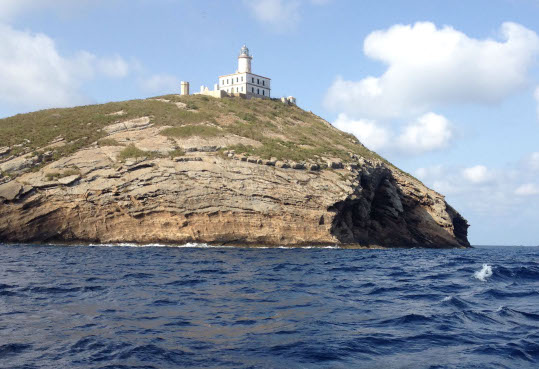A study led by the University confirms that vipers inhabited the Columbretes Islands 2,600 years ago
- Press Office
- June 28th, 2023

An international team led by Postdoctoral Researcher Margarita Salas of the University of Valencia Rafael Marquina, has studied the fossil remains of small vertebrates recovered from the Illa Grossa, the largest island of the archipelago of Columbretes. The paleontological study, published on the journal Comptes Rendus Palevol, allows us to get to know the fauna of small vertebrates that inhabitated on the islet and confirms that the snakes that inhabitated in the archipelago were vipers.
The team studied the fossil remains of small vertebrates recovered from the Illa Grossa, the largest island of the archipelago of Columbretes. The remains come from an excavation carried out in 2005, in which staff from the University of Valencia and the Valencian Department of Environment were looking for information about the vegetation on the island before the changes made by humans and, on the other hand, to clarify the specific identity of the ophidians that existed on Illa Grossa until the 19th century.
Scientists from Spanish, French and Portuguese institutions (University of Valencia, Valencian Natural History Museum, Catalan Human Paleoecology and Human Evolution Institute (Terragona), Catalan Palaeontology-Sabadell Institute, Museum nationelle d’Histoire Naturelle, University of Porto, University of Lisbon and Museu da Lourinha) have participated in the study.
The Columbretes Islands, located some 50 km from Castellón, are a small archipelago of volcanic origin of great environmental value given their geological nature and the biodiversity they contain. The name 'Columbretes' refers to the large number of snakes that inhabited its main island (Illa Grossa); the ancient Greeks knew the island as Ophiusa and the Romans as Colubraria. This high density of snakes made human settlement impossible until the mid-19th century, when it was decided to build a lighthouse on the island between 1856 and 1859. At the same time, a campaign was launched to exterminate the species through the direct elimination of specimens, the introduction of predators (mainly pigs) and the burning of the island's vegetation. As a result, the last record of snakes on Illa Grossa dates back to 1886. Such was the impact of the measures adopted that the island's entire flightless vertebrate fauna was reduced to a single species: the Columbretes lizard (Podarcis liolepis atratus).
The real identity of the ophidian that existed on Columbretes before the permanent human presence on the island has remained one of the most relevant enigmas of the natural space. According to historical chronicles and a specimen preserved in the National Museum of Natural Sciences-CSIC (Madrid) supposedly from Illa Grossa, the species must have been a snub-nosed viper. However, other herpetologists (scientists who study reptiles and amphibians) denied this identity. The opportunity to clarify the identity of the snake and learn more about the vertebrate fauna of the islands came in 2005, when excavations brought to light a large number of remains, mainly vertebrae and venom-inoculating fangs, which confirmed the presence of vipers on Illa Grossa in the past.
In addition to the remains of this ophidian, other vertebrate remains have been found, and thus it has been possible to determine the presence in historical times on Illa Grossa of the Iberian skink (Chalcides bedriagai), a species of small-legged skink lizard endemic to the Iberian Peninsula. Fossils of relatives of the Columbretes lizard have also been found. From the bird group, six taxa have been described, and among mammals, teeth of the house mouse (Mus musculus) have been found. The latter is a very interesting finding given that this species lives in association with human settlements, which determines the oldest evidence of human activity in the archipelago.
More information:
















